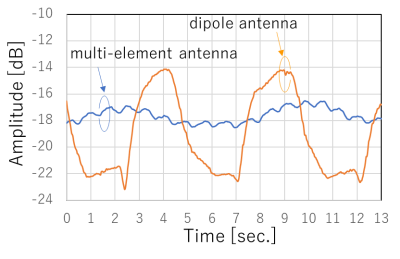4285
Investigation of appropriate frequency band and antenna for non-contact monitoring of heart and respiration rate1Advanced Technology Department, Research and Development Center, Canon Medical Systems Corporation, Kawasaki, Japan
Synopsis
This paper investigates the appropriate frequency band and antenna used for a non-contact heart and respiratory rate monitoring system applying an antenna. As a result of measurements with different resonant frequency antennas, it is found that the appropriate frequency band is around 600 MHz. Furthermore, an antenna having multi resonance elements reduces the influence of abdominal motion in breathing at detecting heart rate.
Introduction
Heart and respiration rates are monitored with skin contact electrodes and bands during MRI procedures. To reducing patient burden and improving work efficiency by eliminating skin contact electrodes and bands, there are some reports on non-contact heart and respiration rates monitoring methods with antennas.1,2 We also investigated the type of antenna for a non-contact heart and respiration rate monitoring method applying antennas.3 However, the suitable frequency band and antenna for the non-contact monitoring has not been entirely studied. This paper investigates the appropriate frequency band for the non-contact monitoring system. Furthermore, the antenna structure is examined for the reduction of influences of abdominal movement in breathing at detecting heart rate.Methods
The schematic measurement system in this investigation is shown in Figure 1. The reflection coefficient of an antenna connected with a network analyzer (Keysight Technologies, E5061B) is measured. A subject lies on a bed in a room without an MRI scanner. In reflection coefficient (S11) measurement, one antenna is 2 mm apart on the chest in lying posture. The time response data of S11 at the resonant frequency of antenna are logged by a computer connected with the network analyzer. Four dipole antennas are used to study the optimal frequency band for the non-contact monitoring system. Each resonant frequency of the four antennas is 300, 400, 500, 600MHz. An antenna having multi resonant elements is also used for investigation of the reduction of influences of abdominal movement.Results and Discussion
Figure 2 shows the S11 time response of four subjects. These results show that the time response waveform has a pattern that includes 5 seconds periodical variation related to breathing and a one-second periodical variation related to heartbeat. Moreover, the S11 time responses at 300 and 500 MHz have a higher tendency not to have a periodical pattern related to heartbeat, or to have an irregular variation than at 400 and 600 MHz. Therefore, it is considered that the frequency used for non-contact heart and respiration rate monitoring is preferably 400 or 600 MHz.Figure 3 shows the S11 time response measured to investigate whether 400 or 600 MHz is the appropriate frequency for non-contact heart and respiration rate monitoring. From these results in fig. 3, the S11 time responses at 600 MHz, excluding subject I, have approximately one second of periodic variation related to heart rate. Irregular variation in the subject I measurement may be due to shifting in the resonant frequency of the antenna by abdominal motion. On the other hand, at 400 MHz, the variation associated with heart rate is often irregular. From the above, the appropriate frequency band or measurement is considered to be around 600 MHz.
Figure 4 shows the multi-element antenna drawing with consideration for reducing the resonant frequency shift during measurement and the frequency characteristics of the multi-element antenna and the dipole antenna with a resonant frequency of 600 MHz. The multi-element antenna is a combination of two dipole antennas with a total length of 18 mm and 14 mm. From the frequency characteristics of the two antennas, it is found that combining two dipole antennas of different resonance lengths makes the half bandwidth of S11 of the multi-element antenna wider than that of the dipole antenna. Moreover, the frequency characteristics in the state of the maximum expiratory position and the maximum inspiratory position are shown, and it can be seen that the multi-element antenna is less affected by abdominal movement due to respiration than the dipole antenna.
Figure 5 shows the S11 time response measured with the multi-element antenna and the dipole antenna. During both measurements, the subject continues to take a deep breath to maximize the influence of abdominal motion. From the results shown in fig. 5, the S11 time response with the multi-element antenna has the periodic variations related to heartbeat and breathing. However, the S11 time response with the dipole antenna has only the variations related to breathing. From the above, it can be said that the multi-element antenna having broad bandwidth is suitable for non-contact heart and respiration rate monitoring.
Conclusion
The appropriate frequency band and antenna for the non-contact monitoring system have been investigated. From the results, the appropriate frequency band for non-contact heart and respiration rate monitoring is around 600 MHz. In addition, the wideband multi-element antenna is suitable for non-contact monitoring. Future works of downsizing of a broadband multi-element antenna and influence evaluation of MRI scanning on the non-contact monitoring will be conducted.Acknowledgements
No acknowledgement found.References
[1] T. Sakamoto et al. Feature-Based Correlation and Topological Similarity for Interbeat Interval Estimation Using Ultrawideband Radar. IEEE Trans. Biomed. Eng. 2016;63(4):747-757.
[2] Y. An et al. Sensitivity Enhanced Vital Sign Detection Based on Antenna Reflection Coefficient Variation. Biomed. Circuits Syst. 2016;1082):319-327.
[3] T. Ohishi, Investigation of antenna effect on non-contact monitoring of heart and respiration rate. Proc. ISMRM 27 (2019).
Figures




